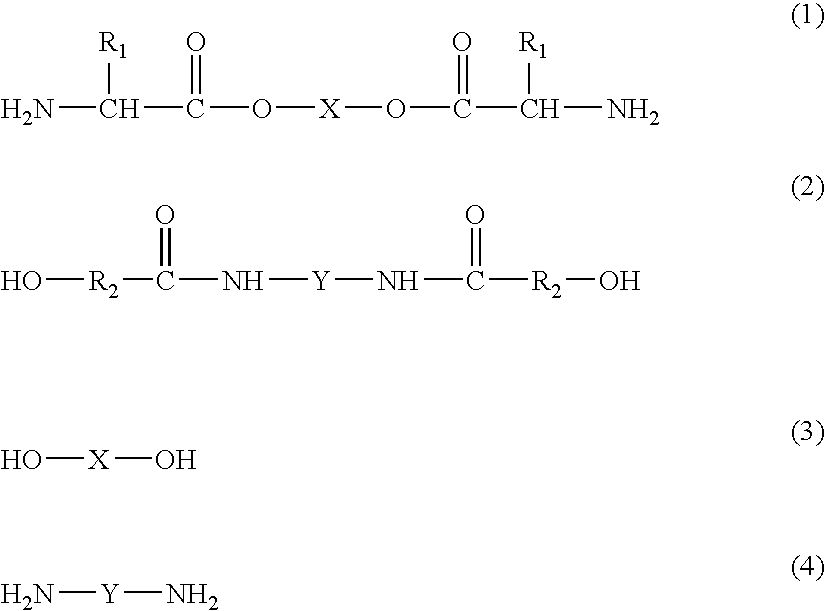Biologically absorbable coatings for implantable devices based on copolymers having ester bonds and methods for fabricating the same
a bio-absorbable, drug-delivering technology, applied in the direction of prosthesis, transportation and packaging, surgery, etc., can solve the problems of intimal flaps or torn arterial linings affecting the patient's recovery,
- Summary
- Abstract
- Description
- Claims
- Application Information
AI Technical Summary
Problems solved by technology
Method used
Image
Examples
example 1
[0129] A copolymer having formula (III) can be synthesized and used in practice of the invention.
[0130] The copolymer (III) is a product of copolymerization of reagents A1, B1, and C1. A1 can be a diol-diamine shown in Table 1 where R1 is i-C4H9 and X is (CH2)6. In other words, A1 can be synthesized by condensation of leucine with 1,6-hexanediol. B1 can be a PEG-diester-diamine shown in Table 4 where R1 is i-C4H9 and PEG300 symbolizes a moiety derived from poly(ethylene glycol) having molecular weight of about 300 Daltons. In other words, B1 can be synthesized by condensation of leucine with poly(ethylene glycol) having molecular weight of about 300 Daltons. C1 can be a dicarboxylic acid shown in Table 5 where R3 is (CH2)8 (sebacic acid, which is also shown in Table 6).
[0131] To synthesize copolymer (III), about 30.8 ml dry triethylamine (about 0.22 mole) in about 55 ml dry solvent N,N′-dimethylacetamide at room temperature can be added to a mixture of: [0132] (a) about 36.37 g (...
example 2
[0136] A copolymer having formula (IV) can be synthesized and used in practice of the invention.
[0137] The copolymer (IV) is a product of copolymerization of reagents A1, B1, and C1. A1 can be a diol-diamine shown in Table 1, where R1 is CH3 and X is (CH2)4. In other words, A1 can be synthesized by condensation of alanine with 1,4-butanediol. B1 can be a PEG-diester-diamine shown in Table 4 where R1 is i-C4H9 and PEG300 symbolizes a moiety derived from poly(ethylene glycol) having molecular weight of about 300 Daltons. In other words, B1 can be synthesized by condensation of alanine with poly(ethylene glycol) having molecular weight of about 300 Daltons. C1 can be a dicarboxylic acid shown in Table 5 where R3 is (CH2)2 (succinic acid, which is also shown in Table 6).
[0138] To synthesize copolymer (IV), about 30.8 ml dry triethylamine (about 0.22 mole), in about 55 ml dry solvent N,N′-dimethylacetamide, at room temperature, can be added to a mixture of: [0139] (a) about 30.43 g (a...
example 3
[0143] A copolymer having formula (V) can be synthesized and used in practice of the invention.
[0144] The copolymer (V) is a product of copolymerization of reagents A1, B1, and C1. A1 can be a diol-diamine shown in Table 1 where R1 is i-C4H9 and X is (CH2)4. In other words, A1 can be synthesized by condensation of leucine with 1,4-butanediol. B1 can be a PEG-diester-diamine shown in Table 4 where R1 is i-C4H9 and PEG300 symbolizes a moiety derived from poly(ethylene glycol) having molecular weight of about 300 Daltons. In other words, B1 can be synthesized by condensation of leucine with poly(ethylene glycol) having molecular weight of about 300 Daltons. C1 can be a dicarboxylic acid shown in Table 5 where R3 is para-C6H4 (terephthalic acid, which is also shown in Table 6).
[0145] The copolymer (V) can be obtained using the same synthetic technique as described in Example 2 for copolymer (IV), except di-para-nitrophenyl terephthalate can be used to make the copolymer (V), instead ...
PUM
| Property | Measurement | Unit |
|---|---|---|
| molecular weight | aaaaa | aaaaa |
| time | aaaaa | aaaaa |
| time | aaaaa | aaaaa |
Abstract
Description
Claims
Application Information
 Login to View More
Login to View More - R&D
- Intellectual Property
- Life Sciences
- Materials
- Tech Scout
- Unparalleled Data Quality
- Higher Quality Content
- 60% Fewer Hallucinations
Browse by: Latest US Patents, China's latest patents, Technical Efficacy Thesaurus, Application Domain, Technology Topic, Popular Technical Reports.
© 2025 PatSnap. All rights reserved.Legal|Privacy policy|Modern Slavery Act Transparency Statement|Sitemap|About US| Contact US: help@patsnap.com



